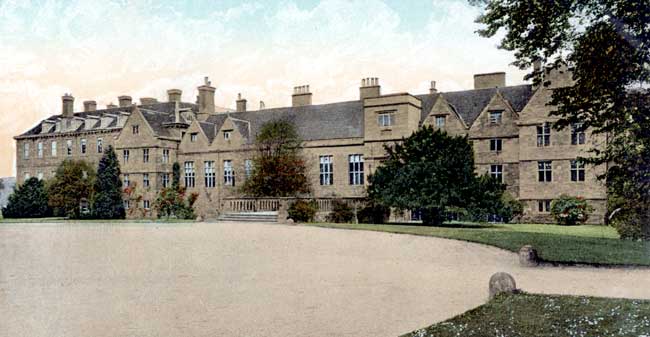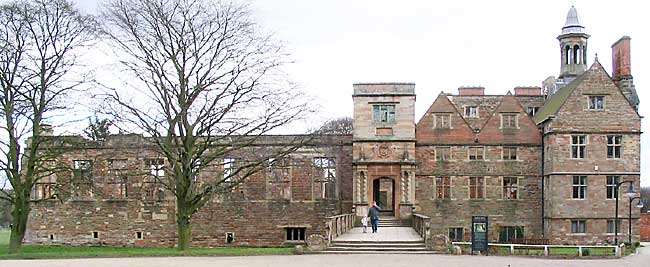Rufford Abbey
By J Bramley

The west front of Rufford Abbey, c.1905, showing the north wing (dating from the 1680s), which was demolished in the mid-1950s.

The west front of Rufford Abbey, 2005.
IT does not seem long since the great mansions in Nottinghamshire were the homes of those who owned them. In a book published just over seventy years ago the author described twenty-five of those houses he had just visited, including Rufford Abbey. Four of them have since been demolished, one partly demolished, while the fate of another has not been settled. Seven have been diverted to other uses and only twelve are still used as homes by their owners, and portions of four of those have been let off. It is natural therefore that a good deal of interest has been aroused in the fate of Rufford Abbey, which ceased to be used as a residence about 1938 since when it has remained empty except while used by the army during the recent war. As there is a certain amount of misconception about the desirability of preserving the abbey or part of it we hope to submit a few comments on that aspect of the matter.
As is usual in these cases there are several known spellings of the word Rufford. Dr. H. Mutschmann studied our place names about forty years ago and suggested that the name may allude to a rough ford in the parish, i.e., a ford of rough water or one difficult to cross. There is a ford although most of the year it is not difficult to cross.
Rufford was held in pre-Conquest days by an Englishman named Ulf but he was replaced by Gilbert de Gand, Earl of Lincoln, when William the Conqueror rewarded his supporters after 1066. It seems likely therefore that Ulf was one of those who opposed William. The Gilbert de Gand who held Rufford in 1148 and founded the abbey in that year was a grandson of Baldwin Earl of Flanders nephew of William the Conqueror with whom he came to England in 1066.
Rievaulx Abbey in Yorkshire became the mother or founding house of Rufford Abbey and in accordance with custom provided the twelve monks needed for opening and running the new abbey at Rufford. The Rievaulx monks were Cistercians, a strict Order founded in 1098 at Citeaux in Burgundy and the Rule under which they lived was mainly drawn up by Stephen Harding an Englishman: a rare occurrence in monastic circles. The Cistercians built their monasteries in remote places and never became popular although
by 1153 they had 330 houses. In one sense they were the most useful of the great Orders as they were competent farmers and specialized in sheep and their fleeces usually fetched top prices and did much to maintain England's place in the wool market until cotton began to replace wool late in the 18th century. Among those who witnessed the Charter which founded this new Cistercian house we find Robert the Chancellor, Earl Simon and Earl William of Arundel. The deed of gift and the Earl's seal still exist and are in good preservation after the passing of 807 years. Lincoln is stated to have made this gift on his death bed. The abbey was dedicated to the honour of Our Beloved Lady Saint Mary the Virgin. The gift was confirmed several times in succeeding years. Much of the land included in the gift passed from the monks in 1538 to the next succeeding owner.
The recorded history of the abbey is like that of most other abbeys and tells only of the everyday life of the monks and is of small historical value. There is no indication that the abbey was ever headed by an outstanding abbot or that the monks contributed anything of value to the life of the nation except as farmers. Edward I and Queen Eleanor stayed the night at the abbey just before the Queen's death in September, 1290, at Harby in this county. The abbey was dissolved in 1538 by Legh and Layton, two of the king's Visitors appointed for that purpose. Each of these men was an agent provocateur and had been instructed accordingly. They made grave charges against Thomas Doncaster the seventeenth and last abbot and against several of his monks but judging by the record of these two worthies we may almost certainly disregard those charges. The net annual income of the abbey when dissolved was £80, at least £4,000 in these days. Doncaster was awarded a pension of £25 per annum, about £1,250 in our money, but it was withdrawn when he was appointed to the living of Rotherham soon afterwards. Rotherham was one of the former abbey's churches. The number of monks when the abbey was dissolved was about fifteen plus a few paid servants: a small company for such a huge mass of buildings. Nothing now remains of the abbey buildings except the crypt, used as a servants' hall later on. The cellars adjoining the crypt have not been altered since the days of the monks. At the foot of the staircase leading to the basement a skeleton was discovered about 1860; there was a bullet hole through the skull. The bones were re-interred in Wellow churchyard.
There is evidence that in many instances these religious houses were plundered by the local inhabitants on the day they were dissolved by the king's Visitors, and the stones taken away for building purposes and the woodwork stolen. About fifty years ago Lord Savile wrote "along the whole length of the hall (the banqueting hall) under the windows runs a narrow oak table, blackened with age, a relic of the Cistercian monks, together with the benches used by them at their meals." In the floor of the chapel aisle there was a tombstone bearing the following inscription in Latin "Robert de Markham a monk of this house who died in 1309." This stone must have been placed there alter removal from the monks' cemetery just cast of the church as monks were not buried in convents. The above-mentioned relics seem to be all that were left after an occupation of some 390 years. The Visitors made a list of the silver and other valuables and ordered them to be sent to London for disposal as directed by the Act, 1536-7, Henry VIII, c. 27. Some valuables were hidden by monks when they learned that the king's Visitors were about to descend on them. It is commonly said that the king gave many of these religious houses and their lands to his favourites but that is not true as most of them were sold at a fair price. In the case of Rufford the facts are rather unusual. As much as remained of the abbey, about 1,000 acres of land and three water mills were demised to Sir John Markham for twenty-one years for £22.8.0 per annum but by letters patent of 6 October 29 Henry VIII, 1537-8, certain castles and other property in Ireland of George Fourth Earl of Shrewsbury were settled on the crown and in exchange the king granted Rufford and certain other manors in Nottinghamshire, Yorkshire, Derbyshire and elsewhere to the Earl for the tenth part of a knight's fee, i.e., £46.15.5.
